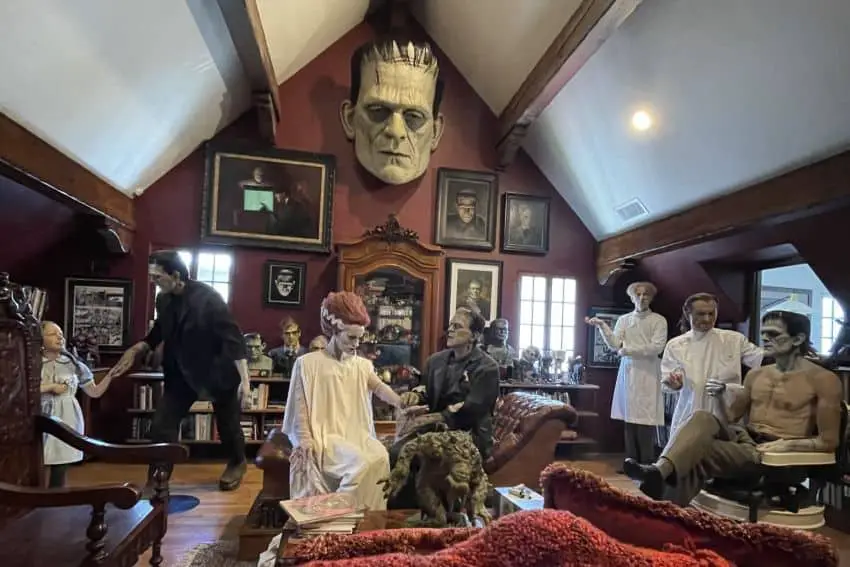Filmmaker Guillermo del Toro, celebrated as one of Mexico’s “Three Amigos” alongside directors Alfonso Cuarón and Alejandro Iñárritu, spent his summer in Scotland filming his long-awaited adaptation of “Frankenstein.” Although del Toro has “no direct blood ties” to the country, he took to social media platform X to express feeling a “deep connection” to Scotland’s gloomy glens and gothic nature.
Posting selfies in graveyards and second-hand bookshops in “Embra” — as he nicknamed Edinburgh, the country’s capital — what most captured my imagination was del Toro’s stream of posts about a haunted hotel room in my birthplace of Aberdeenshire.

Guillermo takes Scotland
Del Toro, who claims he “always stays in the most haunted room,” revealed that despite “high hopes”, he has never yet encountered anything supernatural. This time, however, the 19th-century castle where he was staying — already abandoned by one producer for its “oppressive vibe” — seemed promising.
Whilst del Toro fed his monster-loving audience with promises of discovering the “something’” lurking in the room, locals focused on catching a glimpse of “Frankenstein”’s star-studded cast, including Jacob Elordi, Oscar Isaac and the appropriately named Mia Goth. Trish, the manager of the local Post Office, became a minor social media sensation in her own right after demanding to see the sultry actor Charles Dance, saying: “I’ve asked for him to be sent here immediately!”
In the hypothetical Venn diagram comparing Mexico and Scotland, it seems right that a healthy slice of the crossover should be reserved for Guillermo del Toro’s Netflix adaptation of “Frankenstein.” While Mary Shelley’s iconic novel is set largely in Switzerland, its themes of resurrection and hubris feel at home in Scotland, where science and the macabre have long gone hand-in-hand.
Ancestral callings may also be at play in this merging of influences: del Toro hinted that his sudden passion for Gaelic life could stem from Irish lineage on his mother’s side, and between two cultures that share important ‘threshold’ festivals — Mexico’s Día de los Muertos and Samhain, the Celtic precursor to Halloween — there’s fertile ground for the tale of a creature pacing the liminal space between this life and the next.

Del Toro, who has described himself as a “death groupie” and spent over a decade trying to get this project off the ground, called “Frankenstein” a film he would “kill to make. The high priest of the ostracized, his supernatural societal rejects often remain as deeply human, as their ‘real’ counterparts.
In “Pan’s Labyrinth,” eleven-year-old Ofelia escapes the brutal reality of 1930s Francoist Spain through a sprawling kingdom under her house. In “The Shape of Water,” mute janitor Elisa Esposito begins a romance with an amphibious creature imprisoned by the U.S. government in a Cold War-era Baltimore laboratory.
Set against Mussolini’s interwar Italy, the idols we revere are brought down to scale in “Pinocchio” as del Toro pushes the point that we should be ourselves to be recognized as valid for who we are. At one point the ostracized puppet, looking up at an effigy of Christ in a church, asks “He’s made of wood too. Why do they like him and not me?”.
In del Toro’s uncanny modern-day worlds, overshadowed by authoritarian rule, the Other leaks into and swamps long-held rationale and institutional beliefs. His villains are often those who worship at the altar of man-made power structures, such as “The Shape of Water”’s Strickland, a square-jawed everyman who drives a Cadillac, or the Franco loyalists in “The Devil’s Backbone,” who are more concerned with finding a stash of gold hidden on the grounds of their orphanage rather than the ghost of a boy haunting the premises.

Victor Frankenstein, a scientist blinded by ego, constructs a creature who, like many of del Toro’s antiheroes, exists outside society’s understanding of what a real person should be. Del Toro views imperfection as “one of the most beautiful things,” and is said by his friend Alfonso Cuaron to bring his beloved characters close to the afterlife as a way of “bringing them peace”.
For a filmmaker brought up under the sweltering sun of Guadalajara, del Toro has a chilled Celtic sensibility that, in “Frankenstein,” might fuse Mexico and Scotland’s twinned links with the afterlife. Like Victor Frankenstein, the director is a master of soaking up ideas from the undergrowth and breathing new life into them, resurrecting and reconstructing the outsider to be a distorted but no less realistic reflection of ourselves.
Bettine is from the Highlands of Scotland and now lives in Mexico City, working in film development at The Lift, Mexico’s leading independent audiovisual production company.
